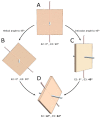Assessing Myocardial Architecture: The Challenges and Controversies
- PMID: 33137874
- PMCID: PMC7711767
- DOI: 10.3390/jcdd7040047
Assessing Myocardial Architecture: The Challenges and Controversies
Abstract
In recent decades, investigators have strived to describe and quantify the orientation of the cardiac myocytes in an attempt to classify their arrangement in healthy and diseased hearts. There are, however, striking differences between the investigations from both a technical and methodological standpoint, thus limiting their comparability and impeding the drawing of appropriate physiological conclusions from the structural assessments. This review aims to elucidate these differences, and to propose guidance to establish methodological consensus in the field. The review outlines the theory behind myocyte orientation analysis, and importantly has identified pronounced differences in the definitions of otherwise widely accepted concepts of myocytic orientation. Based on the findings, recommendations are made for the future design of studies in the field of myocardial morphology. It is emphasised that projection of myocyte orientations, before quantification of their angulation, introduces considerable bias, and that angles should be assessed relative to the epicardial curvature. The transmural orientation of the cardiomyocytes should also not be neglected, as it is an important determinant of cardiac function. Finally, there is considerable disagreement in the literature as to how the orientation of myocardial aggregates should be assessed, but to do so in a mathematically meaningful way, the normal vector of the aggregate plane should be utilised.
Keywords: diffusion tensor imaging; heart; methodology; micro computed tomography; myocardial aggregation; myocyte orientation; review.
Conflict of interest statement
The authors have no conflict of interest.
Figures








Similar articles
-
Anatomically correct assessment of the orientation of the cardiomyocytes using diffusion tensor imaging.NMR Biomed. 2020 Mar;33(3):e4205. doi: 10.1002/nbm.4205. Epub 2019 Dec 12. NMR Biomed. 2020. PMID: 31829484
-
The functional architecture of skeletal compared to cardiac musculature: Myocyte orientation, lamellar unit morphology, and the helical ventricular myocardial band.Clin Anat. 2016 Apr;29(3):316-32. doi: 10.1002/ca.22661. Epub 2015 Nov 23. Clin Anat. 2016. PMID: 26478993 Review.
-
Studying Dynamic Myofiber Aggregate Reorientation in Dilated Cardiomyopathy Using In Vivo Magnetic Resonance Diffusion Tensor Imaging.Circ Cardiovasc Imaging. 2016 Oct;9(10):e005018. doi: 10.1161/CIRCIMAGING.116.005018. Circ Cardiovasc Imaging. 2016. PMID: 27729361 Free PMC article.
-
Helical myofiber orientation after myocardial infarction and left ventricular surgical restoration in sheep.J Thorac Cardiovasc Surg. 2005 Feb;129(2):382-90. doi: 10.1016/j.jtcvs.2004.06.006. J Thorac Cardiovasc Surg. 2005. PMID: 15678050
-
Measuring and mapping cardiac fiber and laminar architecture using diffusion tensor MR imaging.Ann N Y Acad Sci. 2005 Jun;1047:296-307. doi: 10.1196/annals.1341.026. Ann N Y Acad Sci. 2005. PMID: 16093505 Review.
Cited by
-
Application of postmortem imaging modalities in cases of sudden death due to cardiovascular diseases-current achievements and limitations from a pathology perspective : Endorsed by the Association for European Cardiovascular Pathology and by the International Society of Forensic Radiology and Imaging.Virchows Arch. 2023 Feb;482(2):385-406. doi: 10.1007/s00428-022-03458-6. Epub 2022 Dec 24. Virchows Arch. 2023. PMID: 36565335 Free PMC article.
-
Recreating the heart's helical structure-function relationship with focused rotary jet spinning.Science. 2022 Jul 8;377(6602):180-185. doi: 10.1126/science.abl6395. Epub 2022 Jul 7. Science. 2022. PMID: 35857545 Free PMC article.
-
Myocardial mesostructure and mesofunction.Am J Physiol Heart Circ Physiol. 2022 Aug 1;323(2):H257-H275. doi: 10.1152/ajpheart.00059.2022. Epub 2022 Jun 3. Am J Physiol Heart Circ Physiol. 2022. PMID: 35657613 Free PMC article. Review.
-
Geometry Does Impact on the Plane Strain Directions of the Human Left Ventricle, Irrespective of Disease.J Cardiovasc Dev Dis. 2022 Nov 15;9(11):393. doi: 10.3390/jcdd9110393. J Cardiovasc Dev Dis. 2022. PMID: 36421928 Free PMC article.
-
The Myosin Myocardial Mesh Interpreted as a Biological Analogous of Nematic Chiral Liquid Crystals.J Cardiovasc Dev Dis. 2021 Dec 11;8(12):179. doi: 10.3390/jcdd8120179. J Cardiovasc Dev Dis. 2021. PMID: 34940534 Free PMC article. Review.
References
-
- Omann C., Agger P., Bøgh N., Laustsen C., Ringgaard S., Stephenson R.S., Anderson R.H., Hjortdal V., Smerup M. Resolving the natural myocardial remodelling brought upon by cardiac contraction; a porcine ex-vivo cardiovascular magnetic resonance study of the left and right ventricle. J. Cardiovasc. Magn. Reson. 2019;21:1–19. doi: 10.1186/s12968-019-0547-2. - DOI - PMC - PubMed
Publication types
LinkOut - more resources
Full Text Sources

